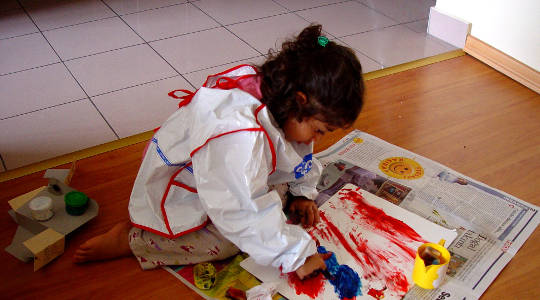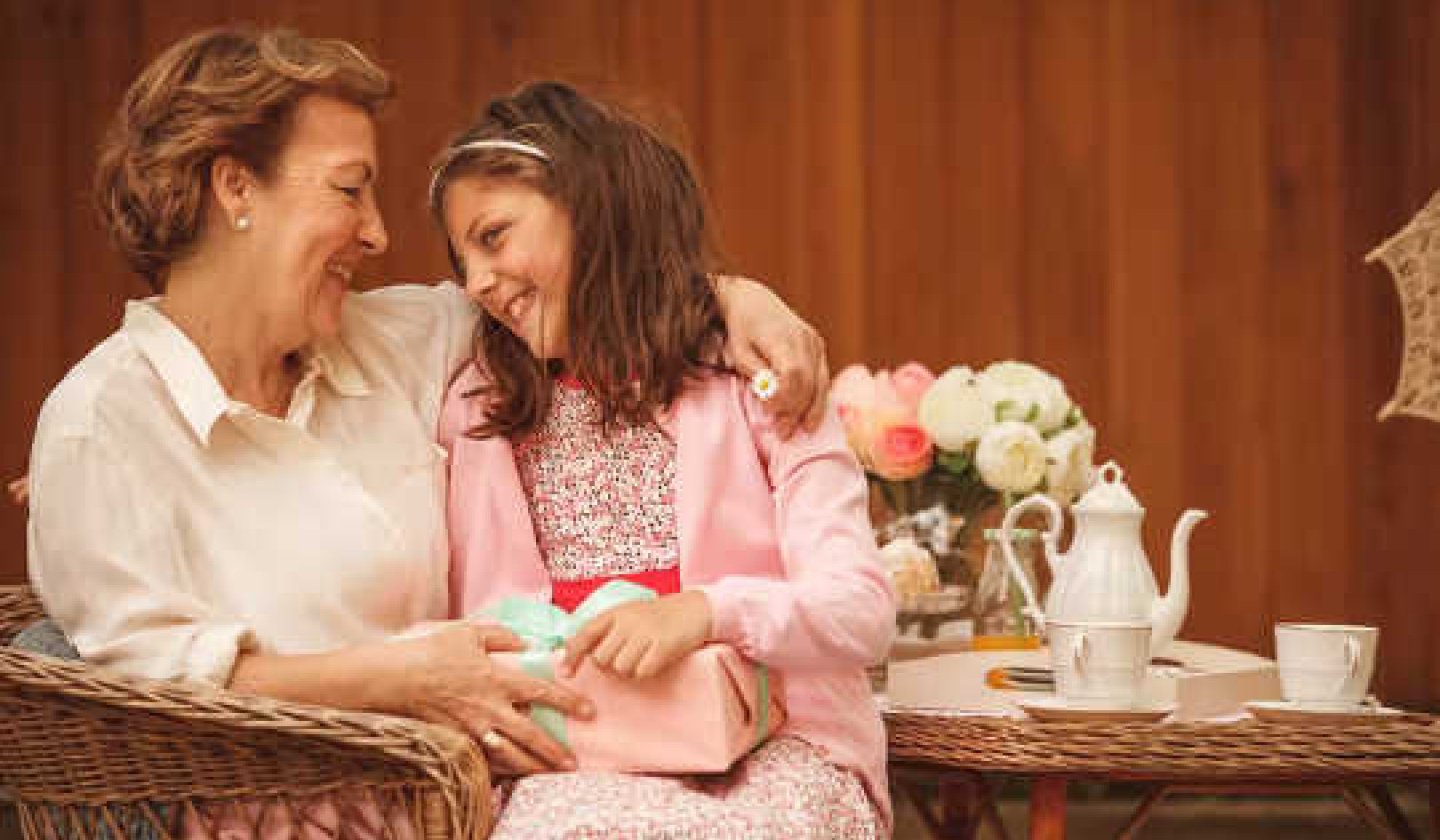
Children need to play. They need the tactile touch of gooey finger paint rather than the sanitary experience of brushing their fingers across a touch pad to make color magically appear on a screen. They need to dig in the dirt, and get dirty. They need to splash in water and get wet. They need to make music and climb trees. They need to wander aimlessly from room to room without an organized activity to occupy them.
A child who is plugged into an electronic babysitter whenever he complains that “there’s nothing to do” becomes an adult who is incapable of being alone with his thoughts for more than fifteen minutes. In The Mindful Brain, Dr. Daniel Siegel says,
The busy lives people lead in the technologically driven culture that consumes our attention often produce a multitasking frenzy of activity that leaves people constantly doing, with no space to breathe and just be. The adaptations to such a way of life often leave youth accustomed to high levels of stimulus-bound attention, flitting from one activity to another, with little time for self-reflection or interpersonal connection of the direct, face-to-face sort that the brain needs for proper development. Little today in our hectic lives provides for opportunities to attune with one another.
This doesn’t mean that kids should be prevented from watching TV or using computers. I am not advocating that we raise a generation of Luddites. The digital era has brought countless benefits into our lives. But given the limitless stimulation offered by electronic devices and the potential exposure to things that are entirely inappropriate, it is crucial that we engage our children early in conversations about using these gadgets so that as they move into the independence of adolescence and are less under our influence, they will be able to make intelligent choices. Like us, they will have to figure out how to balance their plugged-in life with their unplugged one.
Hitting the Off Switch
One day a mother and her twelve-year-old son were having a heated argument in my office about time spent on his devices. Elena complained that her son refused to get off the iPad unless she forced him to by threatening to take it away altogether. “He ignores his chores, procrastinates on homework, and wouldn’t dream of going outside to play.” She said the hardest time was when she was making dinner; Christopher typically got on one device or another while she was occupied in the kitchen and therefore less able to follow through with limits.
Chris maintained that his mom was far too strict. “She’s so much meaner than my friends’ parents. They get to be on the iPad for hours!” I let him air his complaints so that he would be receptive to my input. “There’s nothing to do that’s fun at my house! And I get my homework done. I don’t see why she can’t let me play my games. I’m not bothering anybody!”
Instead of trying to force Chris to embrace the merits of old-fashioned play or convince him that until recently kids managed to enjoy their childhoods quite nicely without the existence of iPads or computers, I invited the two of them to do a visualization with me.
“Close your eyes, and imagine that the three of us are in the exact same spot we’re sitting in now, but it’s ten thousand years ago. There are no buildings or furniture, no cars or electricity. Chris, imagine your mom working around the fire with the other women of the tribe, preparing dinner — maybe grinding seeds or dropping in some of the herbs that you gathered earlier with her. Now, Christopher, I want you to picture yourself in that setting, a young man of the tribe. What are you doing? See yourself there and picture what you’re doing while you wait for the meal.” I let him have some quiet time and then invited them both to open their eyes.
“So, Chris, what were you up to, back when there weren’t any devices?” He said he had pictured himself running around with the other boys, building things, and climbing trees. Elena chimed in, offering that she had imagined him helping the men — who were not that much older than he was — preparing weapons for their next hunt or building a hut.
He smiled as we talked about life back then. “I wish I could live like that now! It was cool!” I was reminded of how challenging it actually is for kids these days, now that opportunities to explore the great outdoors or spend time out in the wild are so rare.
I said as much to Elena, inviting her to see her son’s situation from his vantage point. “Life is different now. It’s hard to resist the temptation to switch on a device when you can’t roam the great outdoors.” His mom nodded, acknowledging the many restrictions of their daily life — including living on a busy city street where it was unsafe to wander too far.
“Chris, would you be willing to make a list of at least ten fun things you could do that didn’t require electricity?” He was surprised by how quickly he was able to come up with ideas, with his mom enthusiastically tossing in possibilities. Elena agreed to help him implement some of the activities on his list, such as getting materials for soap carving or building a small fort in their backyard. The session ended with Chris and his mom feeling more like allies than adversaries.
This exercise didn’t eradicate Christopher’s love affair with his iPad and video games, but it did help him find something else to do when his mother asked him to turn things off.
Steve Jobs’s Kids and the iPad
Many parents justify giving their kids carte blanche when it comes to digital devices because they believe that not doing so will cause their children to fall behind in a competitive world where the tech savvy prevail. In his article “Steve Jobs Was a Low-Tech Parent,” Nick Bilton began with a question he posed to Mr. Jobs as the first tablets were being marketed. “So, your kids must love the iPad?” Jobs’s response? “They haven’t used it....We limit how much technology our kids use at home.” Bilton spoke with Walter Isaacson, author of Steve Jobs, who spent a lot of time at their home and said, “Every evening Steve made a point of having dinner at the big long table in their kitchen, discussing books and history and a variety of things. No one ever pulled out an iPad or computer.”
Chris Anderson, former editor of Wired and chief executive of 3D Robotics, puts time limits as well as parental controls on all the devices in his family’s home. “My kids accuse me and my wife of being fascists and overly concerned about tech, and they say that none of their friends have the same rules,” he said of his five children, ages six to seventeen. “That’s because we have seen the dangers of technology firsthand. I’ve seen it in myself. I don’t want to see that happen to my kids.” Rule number one? “There are no screens in the bedroom. Period. Ever.”
When our guidelines are clear, children adapt. They may push and prod to have more of what they want, but once the power is switched off, they will find something fun to do, just as children have done since time immemorial.
When we fail to set limits because we’re afraid of our children’s meltdowns or we’re feeling guilty about how preoccupied we’ve been with our obligations, we effectively toss our kids into the black hole of the digital world. Children need to live in the 3-D world; it is our responsibility to ensure that they do.
There are no hard-and-fast guidelines for digital use. There may be days when you’re under the weather and your kids watch back-to-back episodes of SpongeBob. You may let them play “educational games” on your iPad while you indulge in a long bath. The problems begin when we abandon our instincts and parent out of fear or guilt.
Leading by Example
There is, of course, another piece we must discuss when talking about raising children who are comfortable being with themselves. We have to show them what that looks like.
Most of us move at a frenetic pace throughout our day, hardly stopping to sit for a meal, let alone to gaze out the window or daydream. The beeps, the tweets, the pings, the rings — we have developed Pavlovian responses to the alerts our devices deliver, often dropping whatever we were doing (including, perhaps, giving our child a few minutes of undivided attention) as soon as one of those bells goes off.
How can we ask our children to be more engaged with the 3-D world or to watch the clouds go by if we aren’t?
In The Joy Diet, Martha Beck talks about stopping our outward momentum for at least fifteen minutes a day. “[The problem is that] perpetually doing, without ever tuning in to the center of our being, is the equivalent of fueling a mighty ship by tossing all its navigational equipment into the furnace.” She goes on to say, “The voice of your true self is so small and still that virtually any distraction can drown it out, especially if you’re just beginning to hear it. You simply cannot develop the skill of listening without carving out and vigorously defending chunks of time during which to do nothing.”
If you want your children to be happy without needing something or someone to drown out the noise of their discontent, unplug the electronics at your house and do nothing now and again. See what happens as you become reacquainted with yourselves, each other, and the simple, satisfying ways that human beings enjoyed life long before landing in the digital world.
©2015 by Susan Stiffelman. All Rights Reserved.
Reprinted with permission of the publisher,
New World Library, Novato, CA 94949. newworldlibrary.com.
Article Source
 Parenting with Presence: Practices for Raising Conscious, Confident, Caring Kids
Parenting with Presence: Practices for Raising Conscious, Confident, Caring Kids
by Susan Stiffelman MFT.
Click here for more info and/or to order this book.
About the Author
 Susan Stiffelman is also the author of Parenting Without Power Struggles and is the Huffington Post’s weekly “Parent Coach” advice columnist. She is a licensed marriage and family therapist, a credentialed teacher, and an international speaker. Susan is also an aspiring banjo player, a middling but determined tap-dancer, and an optimistic gardener. Diagnosed with the ADHD label, she manages to accomplish more in a week than many do in a month, while maintaining a regular meditation practice and spending serious amounts of time playing. Visit her website at www.SusanStiffelman.com.
Susan Stiffelman is also the author of Parenting Without Power Struggles and is the Huffington Post’s weekly “Parent Coach” advice columnist. She is a licensed marriage and family therapist, a credentialed teacher, and an international speaker. Susan is also an aspiring banjo player, a middling but determined tap-dancer, and an optimistic gardener. Diagnosed with the ADHD label, she manages to accomplish more in a week than many do in a month, while maintaining a regular meditation practice and spending serious amounts of time playing. Visit her website at www.SusanStiffelman.com.


























